Australian Housing Affordability: Data Analysis and Findings Report
VerifiedAdded on 2020/04/07
|29
|5626
|72
Report
AI Summary
This report, submitted for a Master of Business and Project Management program, analyzes the state of housing affordability in Australia. The report presents data collected and analyzed from Galaxy Research on various socioeconomic groups' perceptions of homeownership and its affordability. It examines key metrics such as price-to-income ratios, the proportion of household income required for deposits and mortgage servicing, and rental costs across different regions. The report highlights the increasing challenges faced by younger generations in achieving homeownership, the impact of rising property prices, and the concerns of older Australians regarding moving costs. The data analysis section outlines the methodology used, including weighting of data and analysis of housing stress measures. The findings reveal regional disparities in affordability, with Sydney and Melbourne facing more significant challenges. The report concludes by emphasizing the importance of homeownership and the concerns surrounding housing affordability across different demographics.
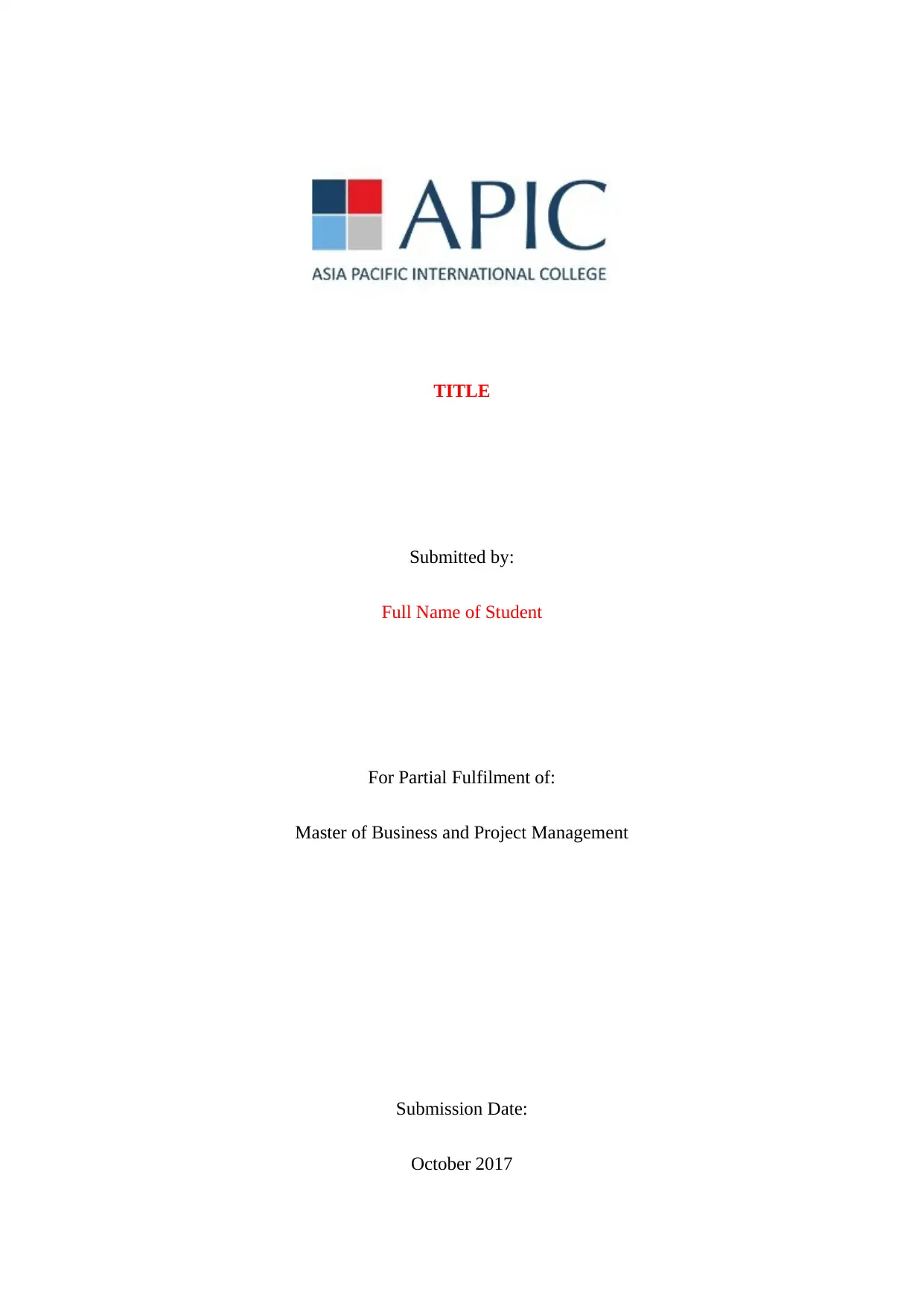
TITLE
Submitted by:
Full Name of Student
For Partial Fulfilment of:
Master of Business and Project Management
Submission Date:
October 2017
Submitted by:
Full Name of Student
For Partial Fulfilment of:
Master of Business and Project Management
Submission Date:
October 2017
Paraphrase This Document
Need a fresh take? Get an instant paraphrase of this document with our AI Paraphraser

2

Table of Contents
1. Data Collection..............................................................................................................................4
2. Data Analysis.................................................................................................................................8
For Data analysis.............................................................................................................................10
3. Findings.......................................................................................................................................12
4. Future Work................................................................................................................................25
5. Conclusion...................................................................................................................................26
6. References...................................................................................................................................27
3
1. Data Collection..............................................................................................................................4
2. Data Analysis.................................................................................................................................8
For Data analysis.............................................................................................................................10
3. Findings.......................................................................................................................................12
4. Future Work................................................................................................................................25
5. Conclusion...................................................................................................................................26
6. References...................................................................................................................................27
3
⊘ This is a preview!⊘
Do you want full access?
Subscribe today to unlock all pages.

Trusted by 1+ million students worldwide
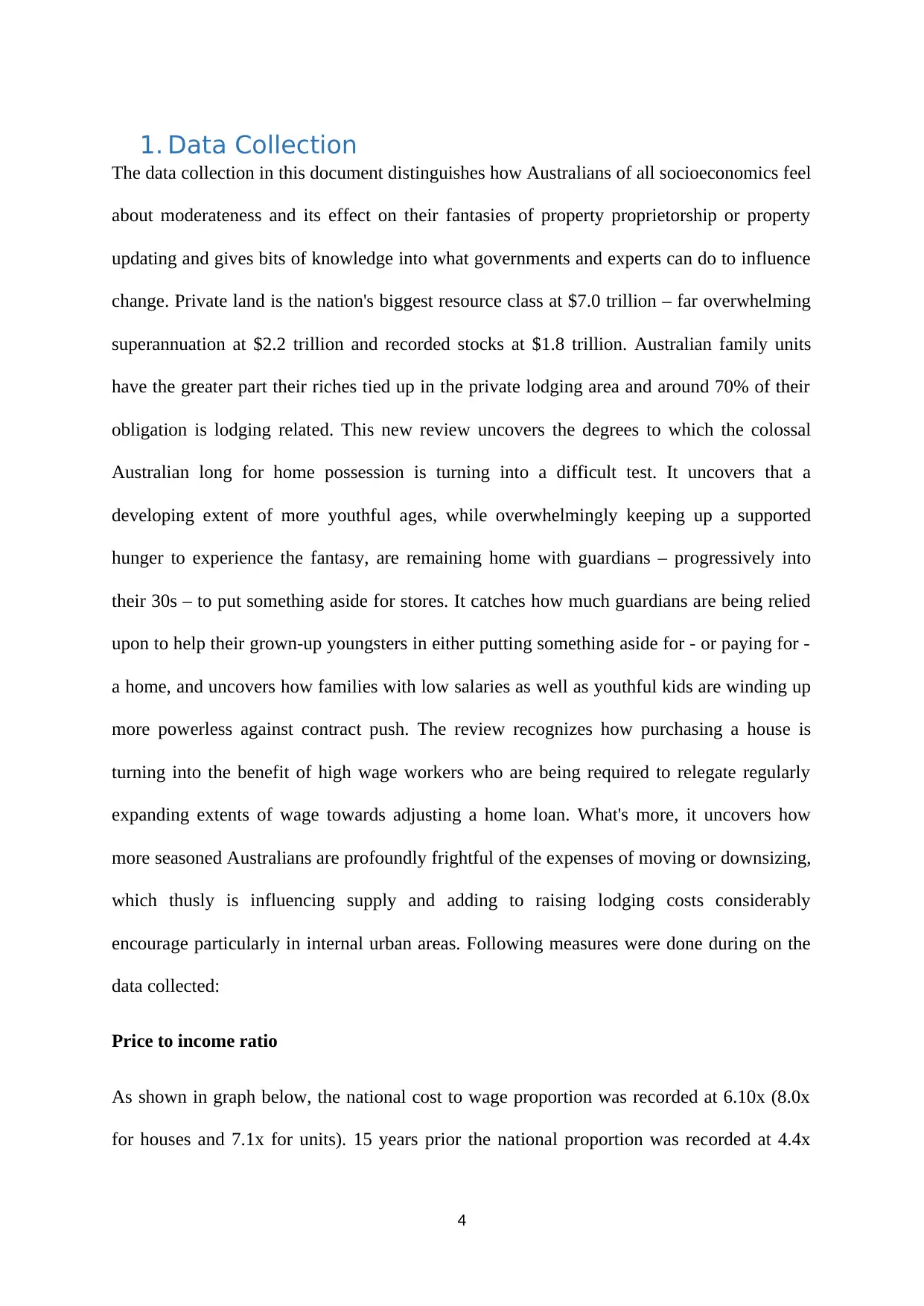
1. Data Collection
The data collection in this document distinguishes how Australians of all socioeconomics feel
about moderateness and its effect on their fantasies of property proprietorship or property
updating and gives bits of knowledge into what governments and experts can do to influence
change. Private land is the nation's biggest resource class at $7.0 trillion – far overwhelming
superannuation at $2.2 trillion and recorded stocks at $1.8 trillion. Australian family units
have the greater part their riches tied up in the private lodging area and around 70% of their
obligation is lodging related. This new review uncovers the degrees to which the colossal
Australian long for home possession is turning into a difficult test. It uncovers that a
developing extent of more youthful ages, while overwhelmingly keeping up a supported
hunger to experience the fantasy, are remaining home with guardians – progressively into
their 30s – to put something aside for stores. It catches how much guardians are being relied
upon to help their grown-up youngsters in either putting something aside for - or paying for -
a home, and uncovers how families with low salaries as well as youthful kids are winding up
more powerless against contract push. The review recognizes how purchasing a house is
turning into the benefit of high wage workers who are being required to relegate regularly
expanding extents of wage towards adjusting a home loan. What's more, it uncovers how
more seasoned Australians are profoundly frightful of the expenses of moving or downsizing,
which thusly is influencing supply and adding to raising lodging costs considerably
encourage particularly in internal urban areas. Following measures were done during on the
data collected:
Price to income ratio
As shown in graph below, the national cost to wage proportion was recorded at 6.10x (8.0x
for houses and 7.1x for units). 15 years prior the national proportion was recorded at 4.4x
4
The data collection in this document distinguishes how Australians of all socioeconomics feel
about moderateness and its effect on their fantasies of property proprietorship or property
updating and gives bits of knowledge into what governments and experts can do to influence
change. Private land is the nation's biggest resource class at $7.0 trillion – far overwhelming
superannuation at $2.2 trillion and recorded stocks at $1.8 trillion. Australian family units
have the greater part their riches tied up in the private lodging area and around 70% of their
obligation is lodging related. This new review uncovers the degrees to which the colossal
Australian long for home possession is turning into a difficult test. It uncovers that a
developing extent of more youthful ages, while overwhelmingly keeping up a supported
hunger to experience the fantasy, are remaining home with guardians – progressively into
their 30s – to put something aside for stores. It catches how much guardians are being relied
upon to help their grown-up youngsters in either putting something aside for - or paying for -
a home, and uncovers how families with low salaries as well as youthful kids are winding up
more powerless against contract push. The review recognizes how purchasing a house is
turning into the benefit of high wage workers who are being required to relegate regularly
expanding extents of wage towards adjusting a home loan. What's more, it uncovers how
more seasoned Australians are profoundly frightful of the expenses of moving or downsizing,
which thusly is influencing supply and adding to raising lodging costs considerably
encourage particularly in internal urban areas. Following measures were done during on the
data collected:
Price to income ratio
As shown in graph below, the national cost to wage proportion was recorded at 6.10x (8.0x
for houses and 7.1x for units). 15 years prior the national proportion was recorded at 4.4x
4
Paraphrase This Document
Need a fresh take? Get an instant paraphrase of this document with our AI Paraphraser

(4.3x for houses and 4.9x for units). The current moderating of middle value development has
seen the two measures really fall a little from their current pinnacles.
Proportion of household income required for a 20% deposit
As per the statistics available it took out138.9% of a family’s salary in September 2016 for a
20% store on a home, 143.2% for a house and 128.9% for a unit. In September 2001 it took
85.9% of a family units wage to buy a home, with figures of 83.4% for a house and 95.7% for
a unit. The information demonstrates that as property costs have kept on surging it has turned
out to be progressively hard to put something aside for a store particularly considering
negligible family pay development.
Extent of family pay required to benefit a 80%
LVR contract 36.8% of a family's pay was required to benefit a 80% LVR contract for a
home in September 2016 with the figures 38.0% for a house and 34.2% for units. In
September 2001 it took 26.8% of family unit pay with a figure of 26.0% for a house and
29.8% for units. This investigation is especially affected by loan fees. In spite of the fact that
financing costs are right now the most minimal they've been in the course of recent years, a
5
seen the two measures really fall a little from their current pinnacles.
Proportion of household income required for a 20% deposit
As per the statistics available it took out138.9% of a family’s salary in September 2016 for a
20% store on a home, 143.2% for a house and 128.9% for a unit. In September 2001 it took
85.9% of a family units wage to buy a home, with figures of 83.4% for a house and 95.7% for
a unit. The information demonstrates that as property costs have kept on surging it has turned
out to be progressively hard to put something aside for a store particularly considering
negligible family pay development.
Extent of family pay required to benefit a 80%
LVR contract 36.8% of a family's pay was required to benefit a 80% LVR contract for a
home in September 2016 with the figures 38.0% for a house and 34.2% for units. In
September 2001 it took 26.8% of family unit pay with a figure of 26.0% for a house and
29.8% for units. This investigation is especially affected by loan fees. In spite of the fact that
financing costs are right now the most minimal they've been in the course of recent years, a
5
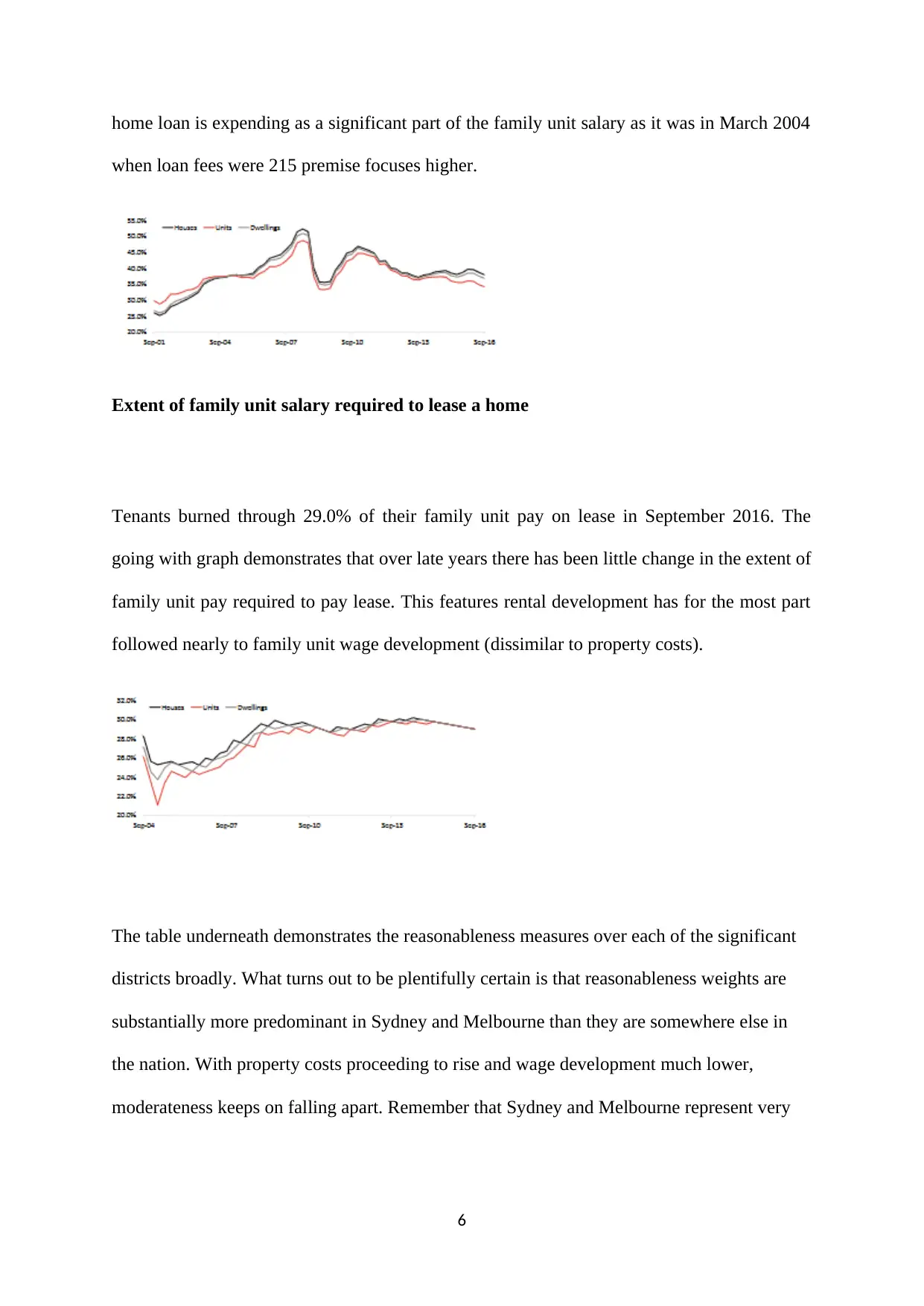
home loan is expending as a significant part of the family unit salary as it was in March 2004
when loan fees were 215 premise focuses higher.
Extent of family unit salary required to lease a home
Tenants burned through 29.0% of their family unit pay on lease in September 2016. The
going with graph demonstrates that over late years there has been little change in the extent of
family unit pay required to pay lease. This features rental development has for the most part
followed nearly to family unit wage development (dissimilar to property costs).
The table underneath demonstrates the reasonableness measures over each of the significant
districts broadly. What turns out to be plentifully certain is that reasonableness weights are
substantially more predominant in Sydney and Melbourne than they are somewhere else in
the nation. With property costs proceeding to rise and wage development much lower,
moderateness keeps on falling apart. Remember that Sydney and Melbourne represent very
6
when loan fees were 215 premise focuses higher.
Extent of family unit salary required to lease a home
Tenants burned through 29.0% of their family unit pay on lease in September 2016. The
going with graph demonstrates that over late years there has been little change in the extent of
family unit pay required to pay lease. This features rental development has for the most part
followed nearly to family unit wage development (dissimilar to property costs).
The table underneath demonstrates the reasonableness measures over each of the significant
districts broadly. What turns out to be plentifully certain is that reasonableness weights are
substantially more predominant in Sydney and Melbourne than they are somewhere else in
the nation. With property costs proceeding to rise and wage development much lower,
moderateness keeps on falling apart. Remember that Sydney and Melbourne represent very
6
⊘ This is a preview!⊘
Do you want full access?
Subscribe today to unlock all pages.

Trusted by 1+ million students worldwide

nearly 40% of the national populace so disintegrating moderateness in these two urban areas
impacts an extensive extent of the general populace.
Region Price to income
ratio
% of
household
income
required for a
20% deposit
% of household
income required
to
service an 80%
LVR
mortgage
% of of
household
income required
to
rent a home
Brisbane 5.7 114.1% 30.3% 25.4%
Australian
Capital
Territory
5.2 103.5% 27.5% 21.4%
Hobart 5.5 110.7% 29.4% 27.4%
Melbourne 7.1 142.8% 37.9% 25.6%
Regional Qld 6.7 134.0% 35.5% 30.0%
Regional NSW 6.6 132.9% 35.2% 29.9%
Regional Vic 5.6 111.2% 29.5% 27.0%
7
impacts an extensive extent of the general populace.
Region Price to income
ratio
% of
household
income
required for a
20% deposit
% of household
income required
to
service an 80%
LVR
mortgage
% of of
household
income required
to
rent a home
Brisbane 5.7 114.1% 30.3% 25.4%
Australian
Capital
Territory
5.2 103.5% 27.5% 21.4%
Hobart 5.5 110.7% 29.4% 27.4%
Melbourne 7.1 142.8% 37.9% 25.6%
Regional Qld 6.7 134.0% 35.5% 30.0%
Regional NSW 6.6 132.9% 35.2% 29.9%
Regional Vic 5.6 111.2% 29.5% 27.0%
7
Paraphrase This Document
Need a fresh take? Get an instant paraphrase of this document with our AI Paraphraser
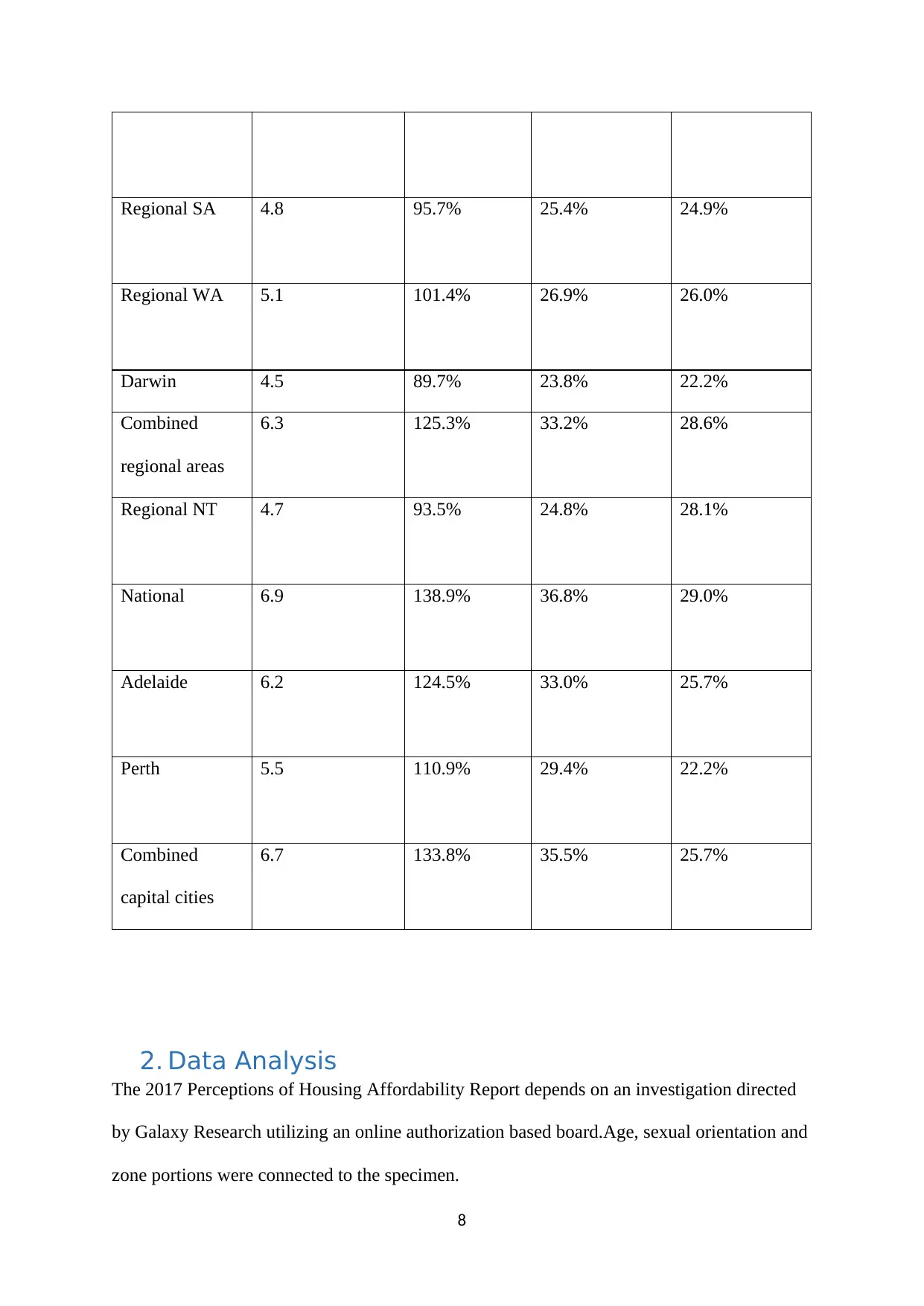
Regional SA 4.8 95.7% 25.4% 24.9%
Regional WA 5.1 101.4% 26.9% 26.0%
Darwin 4.5 89.7% 23.8% 22.2%
Combined
regional areas
6.3 125.3% 33.2% 28.6%
Regional NT 4.7 93.5% 24.8% 28.1%
National 6.9 138.9% 36.8% 29.0%
Adelaide 6.2 124.5% 33.0% 25.7%
Perth 5.5 110.9% 29.4% 22.2%
Combined
capital cities
6.7 133.8% 35.5% 25.7%
2. Data Analysis
The 2017 Perceptions of Housing Affordability Report depends on an investigation directed
by Galaxy Research utilizing an online authorization based board.Age, sexual orientation and
zone portions were connected to the specimen.
8
Regional WA 5.1 101.4% 26.9% 26.0%
Darwin 4.5 89.7% 23.8% 22.2%
Combined
regional areas
6.3 125.3% 33.2% 28.6%
Regional NT 4.7 93.5% 24.8% 28.1%
National 6.9 138.9% 36.8% 29.0%
Adelaide 6.2 124.5% 33.0% 25.7%
Perth 5.5 110.9% 29.4% 22.2%
Combined
capital cities
6.7 133.8% 35.5% 25.7%
2. Data Analysis
The 2017 Perceptions of Housing Affordability Report depends on an investigation directed
by Galaxy Research utilizing an online authorization based board.Age, sexual orientation and
zone portions were connected to the specimen.
8
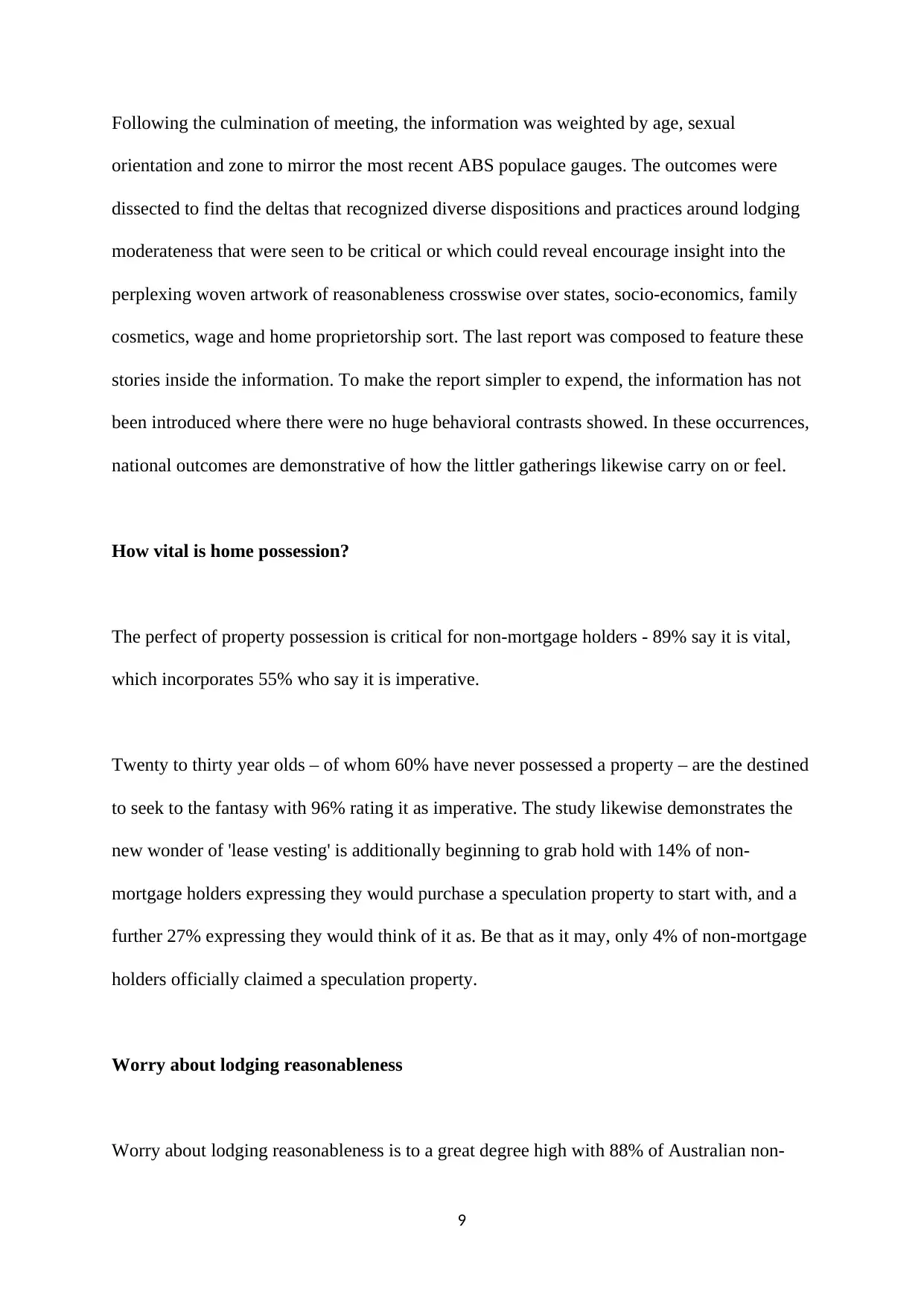
Following the culmination of meeting, the information was weighted by age, sexual
orientation and zone to mirror the most recent ABS populace gauges. The outcomes were
dissected to find the deltas that recognized diverse dispositions and practices around lodging
moderateness that were seen to be critical or which could reveal encourage insight into the
perplexing woven artwork of reasonableness crosswise over states, socio-economics, family
cosmetics, wage and home proprietorship sort. The last report was composed to feature these
stories inside the information. To make the report simpler to expend, the information has not
been introduced where there were no huge behavioral contrasts showed. In these occurrences,
national outcomes are demonstrative of how the littler gatherings likewise carry on or feel.
How vital is home possession?
The perfect of property possession is critical for non-mortgage holders - 89% say it is vital,
which incorporates 55% who say it is imperative.
Twenty to thirty year olds – of whom 60% have never possessed a property – are the destined
to seek to the fantasy with 96% rating it as imperative. The study likewise demonstrates the
new wonder of 'lease vesting' is additionally beginning to grab hold with 14% of non-
mortgage holders expressing they would purchase a speculation property to start with, and a
further 27% expressing they would think of it as. Be that as it may, only 4% of non-mortgage
holders officially claimed a speculation property.
Worry about lodging reasonableness
Worry about lodging reasonableness is to a great degree high with 88% of Australian non-
9
orientation and zone to mirror the most recent ABS populace gauges. The outcomes were
dissected to find the deltas that recognized diverse dispositions and practices around lodging
moderateness that were seen to be critical or which could reveal encourage insight into the
perplexing woven artwork of reasonableness crosswise over states, socio-economics, family
cosmetics, wage and home proprietorship sort. The last report was composed to feature these
stories inside the information. To make the report simpler to expend, the information has not
been introduced where there were no huge behavioral contrasts showed. In these occurrences,
national outcomes are demonstrative of how the littler gatherings likewise carry on or feel.
How vital is home possession?
The perfect of property possession is critical for non-mortgage holders - 89% say it is vital,
which incorporates 55% who say it is imperative.
Twenty to thirty year olds – of whom 60% have never possessed a property – are the destined
to seek to the fantasy with 96% rating it as imperative. The study likewise demonstrates the
new wonder of 'lease vesting' is additionally beginning to grab hold with 14% of non-
mortgage holders expressing they would purchase a speculation property to start with, and a
further 27% expressing they would think of it as. Be that as it may, only 4% of non-mortgage
holders officially claimed a speculation property.
Worry about lodging reasonableness
Worry about lodging reasonableness is to a great degree high with 88% of Australian non-
9
⊘ This is a preview!⊘
Do you want full access?
Subscribe today to unlock all pages.

Trusted by 1+ million students worldwide
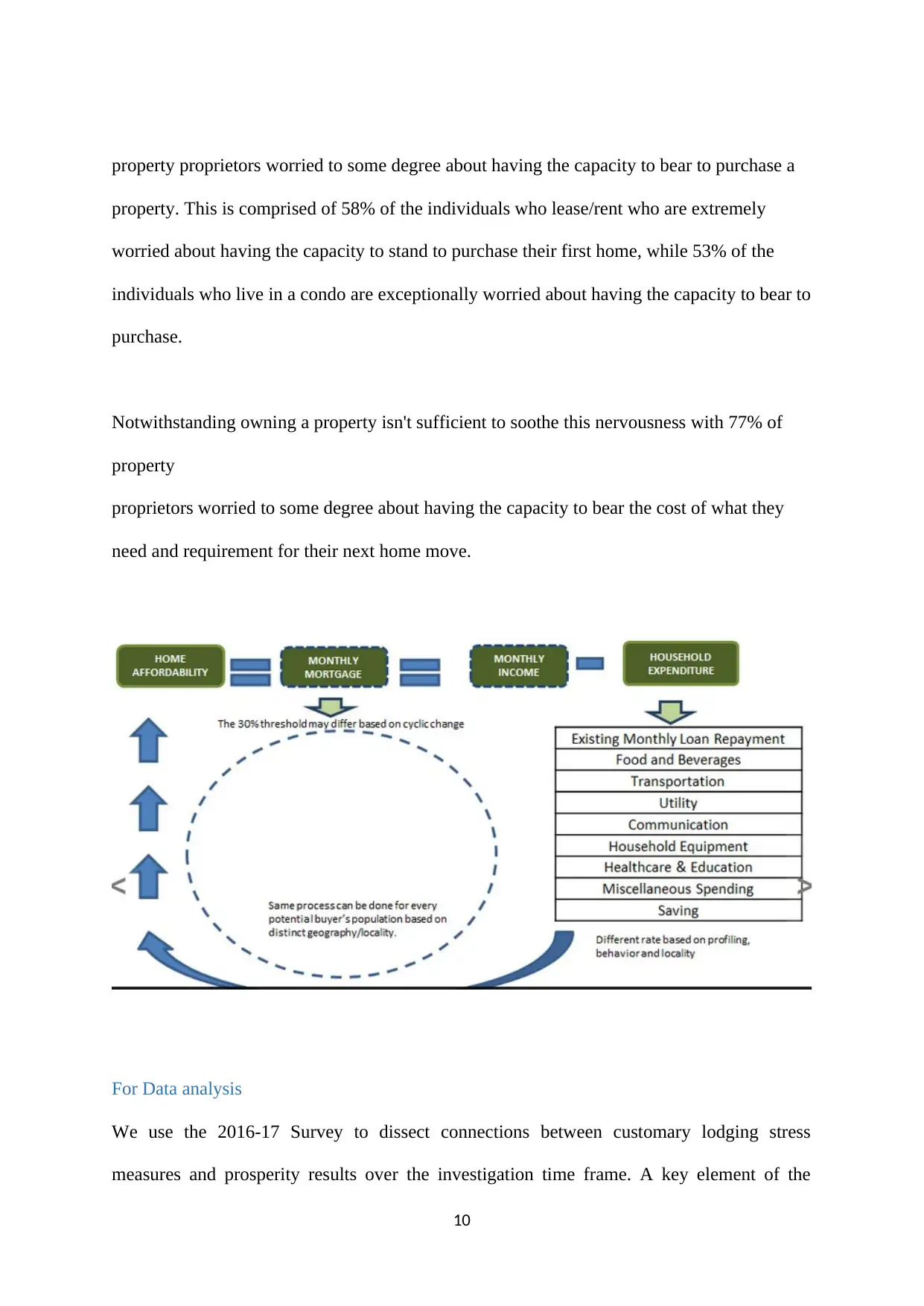
property proprietors worried to some degree about having the capacity to bear to purchase a
property. This is comprised of 58% of the individuals who lease/rent who are extremely
worried about having the capacity to stand to purchase their first home, while 53% of the
individuals who live in a condo are exceptionally worried about having the capacity to bear to
purchase.
Notwithstanding owning a property isn't sufficient to soothe this nervousness with 77% of
property
proprietors worried to some degree about having the capacity to bear the cost of what they
need and requirement for their next home move.
For Data analysis
We use the 2016-17 Survey to dissect connections between customary lodging stress
measures and prosperity results over the investigation time frame. A key element of the
10
property. This is comprised of 58% of the individuals who lease/rent who are extremely
worried about having the capacity to stand to purchase their first home, while 53% of the
individuals who live in a condo are exceptionally worried about having the capacity to bear to
purchase.
Notwithstanding owning a property isn't sufficient to soothe this nervousness with 77% of
property
proprietors worried to some degree about having the capacity to bear the cost of what they
need and requirement for their next home move.
For Data analysis
We use the 2016-17 Survey to dissect connections between customary lodging stress
measures and prosperity results over the investigation time frame. A key element of the
10
Paraphrase This Document
Need a fresh take? Get an instant paraphrase of this document with our AI Paraphraser
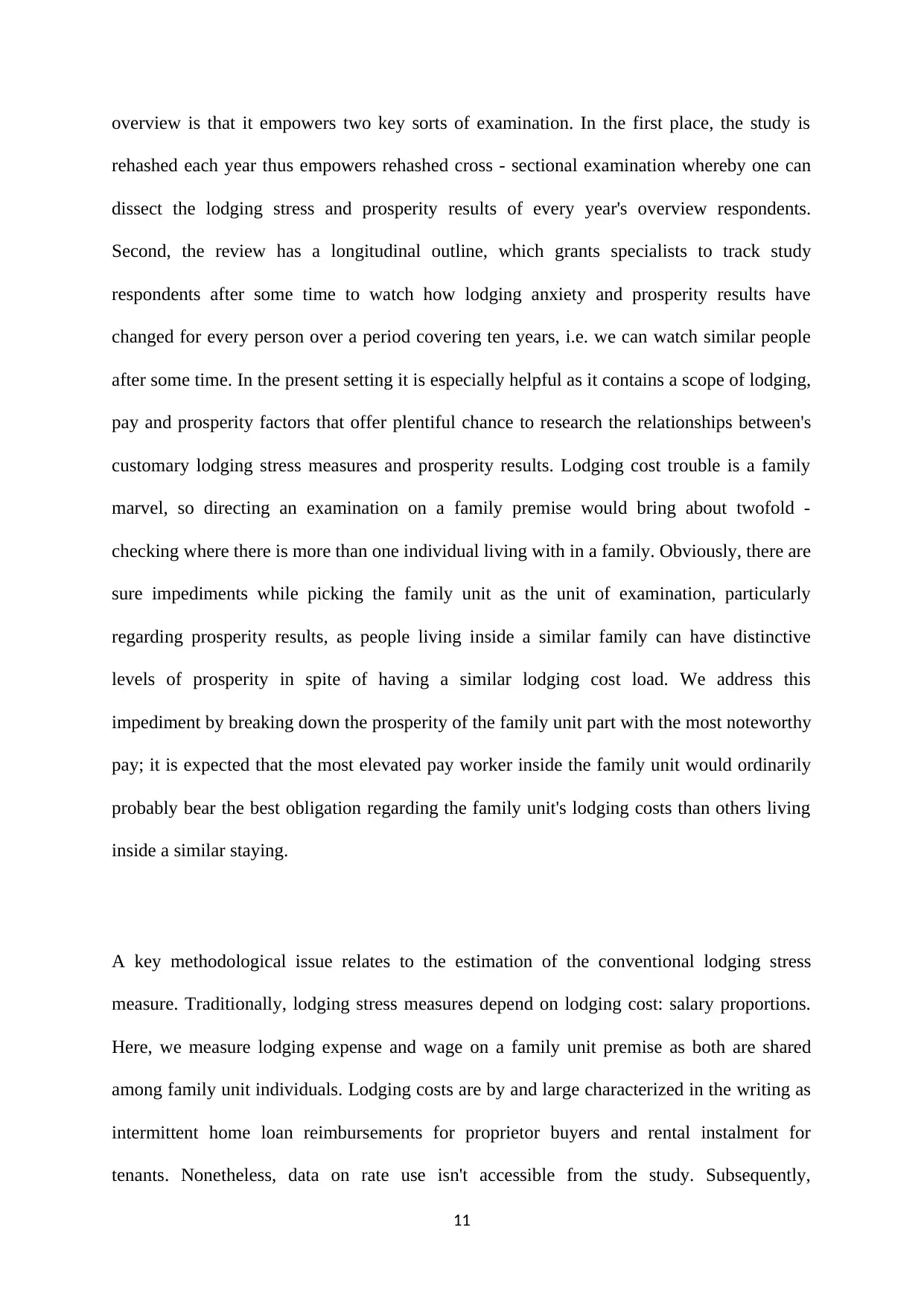
overview is that it empowers two key sorts of examination. In the first place, the study is
rehashed each year thus empowers rehashed cross - sectional examination whereby one can
dissect the lodging stress and prosperity results of every year's overview respondents.
Second, the review has a longitudinal outline, which grants specialists to track study
respondents after some time to watch how lodging anxiety and prosperity results have
changed for every person over a period covering ten years, i.e. we can watch similar people
after some time. In the present setting it is especially helpful as it contains a scope of lodging,
pay and prosperity factors that offer plentiful chance to research the relationships between's
customary lodging stress measures and prosperity results. Lodging cost trouble is a family
marvel, so directing an examination on a family premise would bring about twofold -
checking where there is more than one individual living with in a family. Obviously, there are
sure impediments while picking the family unit as the unit of examination, particularly
regarding prosperity results, as people living inside a similar family can have distinctive
levels of prosperity in spite of having a similar lodging cost load. We address this
impediment by breaking down the prosperity of the family unit part with the most noteworthy
pay; it is expected that the most elevated pay worker inside the family unit would ordinarily
probably bear the best obligation regarding the family unit's lodging costs than others living
inside a similar staying.
A key methodological issue relates to the estimation of the conventional lodging stress
measure. Traditionally, lodging stress measures depend on lodging cost: salary proportions.
Here, we measure lodging expense and wage on a family unit premise as both are shared
among family unit individuals. Lodging costs are by and large characterized in the writing as
intermittent home loan reimbursements for proprietor buyers and rental instalment for
tenants. Nonetheless, data on rate use isn't accessible from the study. Subsequently,
11
rehashed each year thus empowers rehashed cross - sectional examination whereby one can
dissect the lodging stress and prosperity results of every year's overview respondents.
Second, the review has a longitudinal outline, which grants specialists to track study
respondents after some time to watch how lodging anxiety and prosperity results have
changed for every person over a period covering ten years, i.e. we can watch similar people
after some time. In the present setting it is especially helpful as it contains a scope of lodging,
pay and prosperity factors that offer plentiful chance to research the relationships between's
customary lodging stress measures and prosperity results. Lodging cost trouble is a family
marvel, so directing an examination on a family premise would bring about twofold -
checking where there is more than one individual living with in a family. Obviously, there are
sure impediments while picking the family unit as the unit of examination, particularly
regarding prosperity results, as people living inside a similar family can have distinctive
levels of prosperity in spite of having a similar lodging cost load. We address this
impediment by breaking down the prosperity of the family unit part with the most noteworthy
pay; it is expected that the most elevated pay worker inside the family unit would ordinarily
probably bear the best obligation regarding the family unit's lodging costs than others living
inside a similar staying.
A key methodological issue relates to the estimation of the conventional lodging stress
measure. Traditionally, lodging stress measures depend on lodging cost: salary proportions.
Here, we measure lodging expense and wage on a family unit premise as both are shared
among family unit individuals. Lodging costs are by and large characterized in the writing as
intermittent home loan reimbursements for proprietor buyers and rental instalment for
tenants. Nonetheless, data on rate use isn't accessible from the study. Subsequently,
11
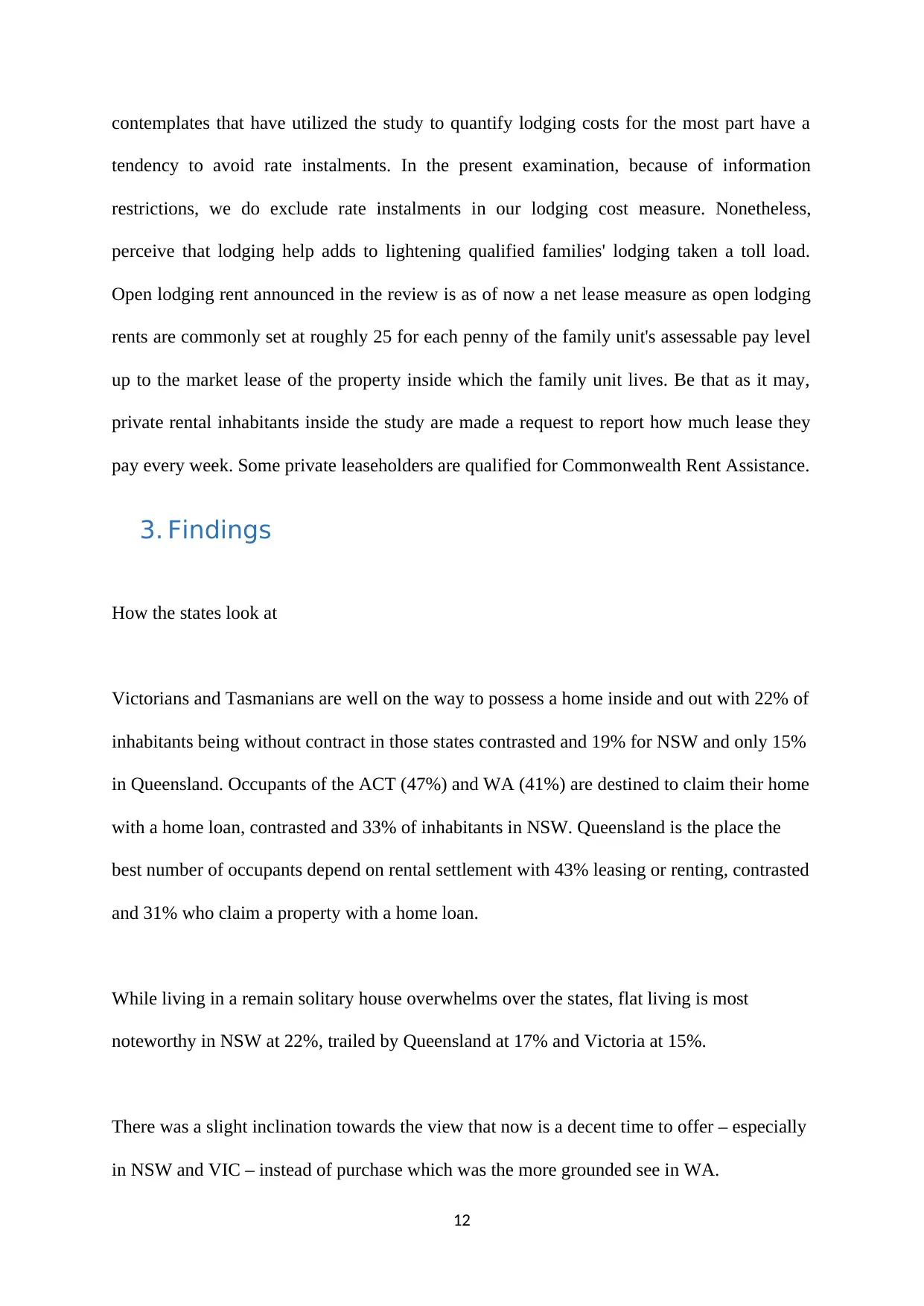
contemplates that have utilized the study to quantify lodging costs for the most part have a
tendency to avoid rate instalments. In the present examination, because of information
restrictions, we do exclude rate instalments in our lodging cost measure. Nonetheless,
perceive that lodging help adds to lightening qualified families' lodging taken a toll load.
Open lodging rent announced in the review is as of now a net lease measure as open lodging
rents are commonly set at roughly 25 for each penny of the family unit's assessable pay level
up to the market lease of the property inside which the family unit lives. Be that as it may,
private rental inhabitants inside the study are made a request to report how much lease they
pay every week. Some private leaseholders are qualified for Commonwealth Rent Assistance.
3. Findings
How the states look at
Victorians and Tasmanians are well on the way to possess a home inside and out with 22% of
inhabitants being without contract in those states contrasted and 19% for NSW and only 15%
in Queensland. Occupants of the ACT (47%) and WA (41%) are destined to claim their home
with a home loan, contrasted and 33% of inhabitants in NSW. Queensland is the place the
best number of occupants depend on rental settlement with 43% leasing or renting, contrasted
and 31% who claim a property with a home loan.
While living in a remain solitary house overwhelms over the states, flat living is most
noteworthy in NSW at 22%, trailed by Queensland at 17% and Victoria at 15%.
There was a slight inclination towards the view that now is a decent time to offer – especially
in NSW and VIC – instead of purchase which was the more grounded see in WA.
12
tendency to avoid rate instalments. In the present examination, because of information
restrictions, we do exclude rate instalments in our lodging cost measure. Nonetheless,
perceive that lodging help adds to lightening qualified families' lodging taken a toll load.
Open lodging rent announced in the review is as of now a net lease measure as open lodging
rents are commonly set at roughly 25 for each penny of the family unit's assessable pay level
up to the market lease of the property inside which the family unit lives. Be that as it may,
private rental inhabitants inside the study are made a request to report how much lease they
pay every week. Some private leaseholders are qualified for Commonwealth Rent Assistance.
3. Findings
How the states look at
Victorians and Tasmanians are well on the way to possess a home inside and out with 22% of
inhabitants being without contract in those states contrasted and 19% for NSW and only 15%
in Queensland. Occupants of the ACT (47%) and WA (41%) are destined to claim their home
with a home loan, contrasted and 33% of inhabitants in NSW. Queensland is the place the
best number of occupants depend on rental settlement with 43% leasing or renting, contrasted
and 31% who claim a property with a home loan.
While living in a remain solitary house overwhelms over the states, flat living is most
noteworthy in NSW at 22%, trailed by Queensland at 17% and Victoria at 15%.
There was a slight inclination towards the view that now is a decent time to offer – especially
in NSW and VIC – instead of purchase which was the more grounded see in WA.
12
⊘ This is a preview!⊘
Do you want full access?
Subscribe today to unlock all pages.

Trusted by 1+ million students worldwide
1 out of 29
Your All-in-One AI-Powered Toolkit for Academic Success.
+13062052269
info@desklib.com
Available 24*7 on WhatsApp / Email
![[object Object]](/_next/static/media/star-bottom.7253800d.svg)
Unlock your academic potential
Copyright © 2020–2026 A2Z Services. All Rights Reserved. Developed and managed by ZUCOL.